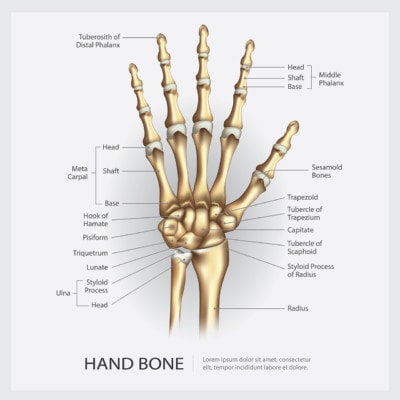There’s a Reason Success Rates for Wrist Replacement Are So Low: It Isn’t the Answer!
You never realize how big a deal your hands are until something goes wrong with them and all of a sudden you can’t write, carry things, or type without pain. There are few good treatment options for problems with wrist arthritis and pain at the base of the thumb, and a recent study showing a scary low wrist replacement success rate isn’t encouraging. In the meantime, understanding that our wrists are all about stability and how they’re treated without surgery could keep you away from invasive procedures with bad results.
How Does the Wrist Work?

Hand Bone with Detail Vector Illustration
The wrist is one of those structures in the body that–when looking at anatomy drawing–you say to yourself, “What the heck is going on here?” You’ll find that there’s 8 irregularly-shaped little bones seemingly crammed between the arm bones and fingers. Why? Because your hand is a complex machine with many moving parts . These little bones allow you to move your fingers in a range of directions that engineers worldwide can’t even replicate without outright ripping off parts of the design.
One of the things that isn’t usually depicted in anatomy drawings that’s critical in understanding the wrist are all of the little ligaments that hold this machine together. The picture to the left makes the complexity of the bones seem mild. Here you’ll see 20 or so ligaments on each side, each darting this way and that in a seemingly random pattern. What’s taking place in this image is all about your hand being able to grasp objects.
While understanding the function of each of these ligaments is beyond this post, the fact that these ligaments are often ignored in wrist treatments is likely why doctors are traditionally so bad at treating this part of the body–and why a prosthetic replacement for this marvel of nature’s complexity is ridiculous. The biomechanics are far too complex to replicate in plastic or steel, which is why wrist replacement success rates are so low.
A New Study Sheds Some Light on Wrist Replacement Success Rates
A new study explores the likelihood of complications following wrist replacement procedures that use an artificial joint. More than 100 surgeries of 3 different types (from complete replacement of the joint to partial replacements in the joint) were performed at an academic teaching hospital specializing in complex wrist surgery. Astonishingly, more than half of the patients reported complications! Serious contracture (when the ligaments and tendons become so scarred down the wrist won’t function) and failure of the implanted devices were the 2 most common side effects of the procedures. Many patients needed additional surgery to correct these issues, with 4 in 10 needing a second procedure and 1 in 10 needing up to 6 additional surgeries! Suffice it to say that the results were a disaster.
Is There a Better Way than Extreme Surgery to Heal the Wrist?
If we return to the diagrams above, it’s not hard to see why these surgeries are failing. The wrist is so complex that no amount of simple joint replacement devices or half-baked surgeries will ever be able to fix it without major issues. Why not try to heal what’s already there instead? Why not try to make nature’s crazy complexity work for you instead of against you? This is our approach to wrist treatment at Regenexx.
First, realize that usually what injures the wrist is a trauma that leads to 1 or more of the ligaments becoming loose. This then leads to extra motion in 1 or more of the 8 wrist bones which wears away cartilage over time. Hence, treatment should focus on restoring the integrity of the wrist ligaments. Thankfully, it turns out that ultra-precise, guided injections of new autologous biologics like platelet rich plasma and stem cells are great for helping the damaged ligaments heal.
As an example, we frequently see patients that first notice wrist pain during yoga. Sometimes it worsens to the point that certain poses can’t be performed or must be heavily modified. A detailed exam looking for wrist instability usually shows that at least 1 wrist ligament is lax, commonly related to an old injury that may or may not be easily recalled by the patient. Usually with 1 or 2 precise injections under ultrasound guidance we can reduce or eliminate the pain and help the patient avoid surgery. If left untreated, most of these patients would end up getting steroid shots, which would hurt cartilage in the wrist joints and inhibit the healing of the damaged ligaments, leading to eventual arthritis and surgery.
Wrist pain and arthritis can usually be easily treated without surgery and with precise injections. Right now, as this new study shows, considering a wrist joint replacement is not a good idea, as the technology just isn’t ready for prime time. Regenexx injection methods have been developed for a decade and are a better first choice for healing the pain in your wrists for good.

If you have questions or comments about this blog post, please email us at [email protected]
NOTE: This blog post provides general information to help the reader better understand regenerative medicine, musculoskeletal health, and related subjects. All content provided in this blog, website, or any linked materials, including text, graphics, images, patient profiles, outcomes, and information, are not intended and should not be considered or used as a substitute for medical advice, diagnosis, or treatment. Please always consult with a professional and certified healthcare provider to discuss if a treatment is right for you.